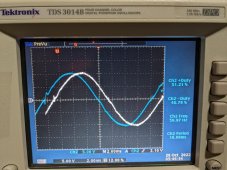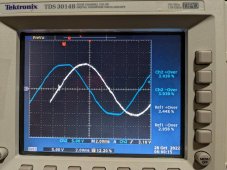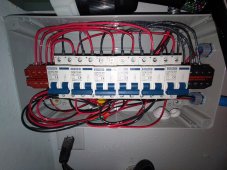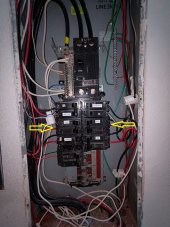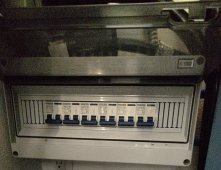Curious, does your model inverter have L1 and L2?So far none of the fixes proposed have alleviated the issue. Still a work in progress. The wife's hair straightener causes all kinds of havoc on the lighting just like your sous vide cooker.
You are using an out of date browser. It may not display this or other websites correctly.
You should upgrade or use an alternative browser.
You should upgrade or use an alternative browser.
SunGold Power SP6548 Flickering lights after new install
- Thread starter nofear72784
- Start date
nofear72784
New Member
- Joined
- Jul 15, 2022
- Messages
- 181
It's a 120v only unit
I captured the zero crossing being what caused my LED dimmer to actually turn off for 1-2 seconds. The white trace is the saved waveform and blue being the live waveform. The white trace did not cause the flicker.Line voltage dimmers are either forward phase control or reverse phase control.
When incandescent lightning was the norm almost all were forward phase control. In this mode the dimmer waits a certain amount of time from the zero crossing point in the sine wave to turn on and turns off again at the next zero crossing to wait the appropriate time before turning on again. This was fine with incandescent filaments as the filament could absorb the sudden voltage spike. The exception being large filaments which would audibly "sing" due to the filament moving with the alternating magnetic fields.
As fluorescent and low voltage fixtures became more common it was necessary for dimmers to change to reverse phase control since magnetic xfmrs do not like the sudden inrush voltage. In this mode the sine wave starts ar the zero crossing point and turns off at some point in the sine wave.
Electronic drivers for led lights changed all this. While the led themselves are usually pwm controlled the driver still uses the sine wave timing to determine the pwm output. So the quality of the incoming sine wave will have an effect on the dimmer timing and the led driver's interpretation of this signal.
I don't claim to know all (or any) of the details of specific products. This is just my general observation from 25 years in the dimming industry (and I've been retired for 10).
YMMV, etc.
Attachments
Quattrohead
Solar Wizard
BTW just got an email for black friday sale, pair of SP6548 now $2252 instead of the $2385 I paid a few moths back during a previous sale + bonus higher PV input voltage !!!
Support our foreign friends haha ?
Support our foreign friends haha ?
nofear72784
New Member
- Joined
- Jul 15, 2022
- Messages
- 181
I am STILL going back and forth with them! Basically it's a design defect that they claim goes all the way back to the base design. IE no way to fix it. But, they are continuing to use this design..... wthBTW just got an email for black friday sale, pair of SP6548 now $2252 instead of the $2385 I paid a few moths back during a previous sale + bonus higher PV input voltage !!!
Support our foreign friends haha ?
DanielS
New Member
Sorry, I’ve been loosely following this massive thread…are you saying there is a known design defect in the 6548’s that causes flickering?I am STILL going back and forth with them! Basically it's a design defect that they claim goes all the way back to the base design. IE no way to fix it. But, they are continuing to use this design..... wth
Quattrohead
Solar Wizard
Sounds like complete bollocks to me.I am STILL going back and forth with them! Basically it's a design defect that they claim goes all the way back to the base design. IE no way to fix it. But, they are continuing to use this design..... wth
Maybe we should start a new thread with LV6548 and EG4 6500 etc in the title to see if all of those cause flickering lights too.
I also see a few people that have poor 120v output regulation too.
I think there has been a batch made during/after covids that have a bad component in them that cause instability, that's all. Supply chain issue.
DanielS
New Member
I think I’m in that group of LV6548’s with flicker. I need to get a scope on this thing to see if it’s isolated to just one unit. I’ve had one unit give me a lot more issues than the other. I need to do more to isolate and characterize the issue.Sounds like complete bollocks to me.
Maybe we should start a new thread with LV6548 and EG4 6500 etc in the title to see if all of those cause flickering lights too.
I also see a few people that have poor 120v output regulation too.
I think there has been a batch made during/after covids that have a bad component in them that cause instability, that's all. Supply chain issue.
Electric_Blue
New Member
- Joined
- Nov 16, 2022
- Messages
- 15
I purchased two of the Sungold Power TP6048 units and installed them in parallel. I wish I would have come across this thread though before making that purchase. The power quality from these units is so poor there is no way I can keep using them. I am well acquainted with "Cindy" over at SGP tech support. I laughed when I saw her name here in an email. Poor thing is probably the only tech working the emails. SGP sent me 2 brand new motherboards to replace myself as a part of the "warranty coverage". If you guys have never torn down one of these, it was about 3 hours per unit to do the full R&R. Guess what? Didn't change anything. Running one unit in battery mode only, produces pretty clean power, no flicker and I would be happy with this. Bring the second unit online and lights flicker and you can hear audible screeching from the units that coincide with the flickering of the lights. Flip the feed breakers from the utility panel on and even though they are running on batt the flickering gets markedly worse and you can put your hand on the units and feel the maelstrom going on inside the big iron core. Turn on the PV feeds to the units and the flickering is so annoying that I turn off the utility feed. I can totally sympathize with the exasperation in "nofear"'s posts. I'm over it. Unless you have a couple of thousand dollars to pee away on some self-inflicted sadistic torture, please do not buy these.
One thing I would mention that nobody has mentioned here is that not only do my LED lights in the house flicker and I have plenty of them in closets and whatnot that do not have dimmers and still flicker is that I have LED lights that flicker WHEN THE POWER IS OFF lol. I can even turn off the feed breakers for the circuits and the leds are still strobing dimly in the dark. I thought there was a lightning storm in my master bath one night. Some aspect of the Chinese engineering is causing power on the neutral enough to dimly flicker some leds. This effect goes away with only one inverter "online".
I have these connected to 8 EG4-LL units so I am going to purchase their brand inverters. I figure I will get nice integrated BMS comm and US-based technical support from a US-based company in Signature Solar.
One thing I would mention that nobody has mentioned here is that not only do my LED lights in the house flicker and I have plenty of them in closets and whatnot that do not have dimmers and still flicker is that I have LED lights that flicker WHEN THE POWER IS OFF lol. I can even turn off the feed breakers for the circuits and the leds are still strobing dimly in the dark. I thought there was a lightning storm in my master bath one night. Some aspect of the Chinese engineering is causing power on the neutral enough to dimly flicker some leds. This effect goes away with only one inverter "online".
I have these connected to 8 EG4-LL units so I am going to purchase their brand inverters. I figure I will get nice integrated BMS comm and US-based technical support from a US-based company in Signature Solar.
Bud Martin
Solar Wizard
- Joined
- Aug 27, 2020
- Messages
- 4,843
Did you mention about the LED lamp flicker to SS to see if they also have an issue or not?
Quattrohead
Solar Wizard
Those TP6048 sound like complete crap, seems like they are not syncing up properly and just fighting each other.
Can you connect them separately to 2 different panels or split the loads between them so they only have the battery as a common connection ?
I also have a Growatt 6000T that produces a perfect sine wave, better that the utility so it should be possible for SP/LV etc to do the same.
Can you connect them separately to 2 different panels or split the loads between them so they only have the battery as a common connection ?
I also have a Growatt 6000T that produces a perfect sine wave, better that the utility so it should be possible for SP/LV etc to do the same.
Quattrohead
Solar Wizard
You should read around here more before expecting better service from certain other companies LOLI have these connected to 8 EG4-LL units so I am going to purchase their brand inverters. I figure I will get nice integrated BMS comm and US-based technical support from a US-based company in Signature Solar.
Cheap chinese shit will always be cheap chinese shit.
Electric_Blue
New Member
- Joined
- Nov 16, 2022
- Messages
- 15
I dont want to do any more work with my panels. I tore my drywall out to put in an isolated panel and moved all the circuits that I wanted in the house on solar onto that one and paid a guy to come and redo the drywall so I'm not going back to that. SS Sells a bunch of different inverter hardware including Schneider. You just gotta pay, and I just might.
On a positive note, I bonded the neutral on my inverter panel and it got rid of that neutral power issue that was strobing my powered-off LEDs. Others have stated as much here that the manuals provided with these units are complete crap. No mention of neutral bonding at all. I found people here stating that the unit switches the bonding depending on the mode (batt mode bonds N-G, Passthrough passes through neutral with utility bond) but not the ones I have apparently. When I checked the continuity between the N-G there was zero in PV/Batt mode. But turning the utility power back on introduces a flickering in the lights and the magnetic chaos inside the units still so not a panacea.
One more thing for anybody working on these, I can't be sure about your unit but mine delivered quite a wake-up call to my body in the form of 120V AC leaking from the PV MPPT to ground when the unit has utility power supplied. It's dangerous and there should be some warning about this because I never expected to come into contact with that working on the DC side bus. Inside my combiner box of all things. There isn't any on the battery terminals.
On a positive note, I bonded the neutral on my inverter panel and it got rid of that neutral power issue that was strobing my powered-off LEDs. Others have stated as much here that the manuals provided with these units are complete crap. No mention of neutral bonding at all. I found people here stating that the unit switches the bonding depending on the mode (batt mode bonds N-G, Passthrough passes through neutral with utility bond) but not the ones I have apparently. When I checked the continuity between the N-G there was zero in PV/Batt mode. But turning the utility power back on introduces a flickering in the lights and the magnetic chaos inside the units still so not a panacea.
One more thing for anybody working on these, I can't be sure about your unit but mine delivered quite a wake-up call to my body in the form of 120V AC leaking from the PV MPPT to ground when the unit has utility power supplied. It's dangerous and there should be some warning about this because I never expected to come into contact with that working on the DC side bus. Inside my combiner box of all things. There isn't any on the battery terminals.
Zwy
Solar Wizard
Put up a wiring diagram, I'd like to see it.I dont want to do any more work with my panels. I tore my drywall out to put in an isolated panel and moved all the circuits that I wanted in the house on solar onto that one and paid a guy to come and redo the drywall so I'm not going back to that. SS Sells a bunch of different inverter hardware including Schneider. You just gotta pay, and I just might.
On a positive note, I bonded the neutral on my inverter panel and it got rid of that neutral power issue that was strobing my powered-off LEDs. Others have stated as much here that the manuals provided with these units are complete crap. No mention of neutral bonding at all. I found people here stating that the unit switches the bonding depending on the mode (batt mode bonds N-G, Passthrough passes through neutral with utility bond) but not the ones I have apparently. When I checked the continuity between the N-G there was zero in PV/Batt mode. But turning the utility power back on introduces a flickering in the lights and the magnetic chaos inside the units still so not a panacea.
One more thing for anybody working on these, I can't be sure about your unit but mine delivered quite a wake-up call to my body in the form of 120V AC leaking from the PV MPPT to ground when the unit has utility power supplied. It's dangerous and there should be some warning about this because I never expected to come into contact with that working on the DC side bus. Inside my combiner box of all things. There isn't any on the battery terminals.
RV10flyer
Solar Wizard
- Joined
- Mar 8, 2021
- Messages
- 1,198
When working around any solar or electrical equipment in general….ALWAYS use a meter. I was wiring a new array into my PV input on one of my Sol-Ark 12K’s. I measured 230VDC+ on the neg PV INPUT to Earth Ground!!! I turned off the PV switch on LH side…0VDC on everything. I can’t explain why, but my meter told me why I shouldn’t touch those wires with bare hands.I dont want to do any more work with my panels. I tore my drywall out to put in an isolated panel and moved all the circuits that I wanted in the house on solar onto that one and paid a guy to come and redo the drywall so I'm not going back to that. SS Sells a bunch of different inverter hardware including Schneider. You just gotta pay, and I just might.
On a positive note, I bonded the neutral on my inverter panel and it got rid of that neutral power issue that was strobing my powered-off LEDs. Others have stated as much here that the manuals provided with these units are complete crap. No mention of neutral bonding at all. I found people here stating that the unit switches the bonding depending on the mode (batt mode bonds N-G, Passthrough passes through neutral with utility bond) but not the ones I have apparently. When I checked the continuity between the N-G there was zero in PV/Batt mode. But turning the utility power back on introduces a flickering in the lights and the magnetic chaos inside the units still so not a panacea.
One more thing for anybody working on these, I can't be sure about your unit but mine delivered quite a wake-up call to my body in the form of 120V AC leaking from the PV MPPT to ground when the unit has utility power supplied. It's dangerous and there should be some warning about this because I never expected to come into contact with that working on the DC side bus. Inside my combiner box of all things. There isn't any on the battery terminals.
Electric_Blue
New Member
- Joined
- Nov 16, 2022
- Messages
- 15
Lesson learned for sure. I took care to disconnect the PV strings and in my mind, there was no other source of input power.When working around any solar or electrical equipment in general….ALWAYS use a meter. I was wiring a new array into my PV input on one of my Sol-Ark 12K’s. I measured 230VDC+ on the neg PV INPUT to Earth Ground!!! I turned off the PV switch on LH side…0VDC on everything. I can’t explain why, but my meter told me why I shouldn’t touch those wires with bare hands.
Electric_Blue
New Member
- Joined
- Nov 16, 2022
- Messages
- 15
Well......wiring diagrams are nice pretty things. I can't say I have the patience to make a nice pretty thing but I put this together... I am including a couple of photos to spare myself from drawing out the details. The distribution panel is backfed through a couple of phase-aligned 40A breakers from the inverters. The utility panel feeds the inverters through a couple of phase-aligned 40 amp breakers. I built my combiner myself from a DIN project box. Each string feeds a 10A double pole DC breaker and I combine them in terminal blocks. Then I tap those split blocks 2x2 with a pair of 20A dual pole DC breakers for the inverter PV feeds.Put up a wiring diagram, I'd like to see it.
Attachments
Electric_Blue
New Member
- Joined
- Nov 16, 2022
- Messages
- 15
I kept the panels side by side to make moving the wiring easier and the drywall guy built a nice box at the top so I wouldnt have to tear up my header like they did in the old days. They dont want you doing that these days so all my conduit comes in front of my wall header now.Well......wiring diagrams are nice pretty things. I can't say I have the patience to make a nice pretty thing but I put this together... I am including a couple of photos to spare myself from drawing out the details. The distribution panel is backfed through a couple of phase-aligned 40A breakers from the inverters. The utility panel feeds the inverters through a couple of phase-aligned 40 amp breakers. I built my combiner myself from a DIN project box. Each string feeds a 10A double pole DC breaker and I combine them in terminal blocks. Then I tap those split blocks 2x2 with a pair of 20A dual pole DC breakers for the inverter PV feeds.
Attachments
RV10flyer
Solar Wizard
- Joined
- Mar 8, 2021
- Messages
- 1,198
As long as it’s safe, reliable and easy to repair, that is what’s important to me. I’m happy with mine. It’s not perfect, but I’ve had 0 power outages since March 4, 2022! I can’t say the same when we “rented- nothing to show for it” power from our greedy, corrupt, overpaid, power company execs in town. When your power company president, judge executive, sheriff and school superintendent are the highest paid in your town, you know you live in a government ran hole.I kept the panels side by side to make moving the wiring easier and the drywall guy built a nice box at the top so I wouldnt have to tear up my header like they did in the old days. They dont want you doing that these days so all my conduit comes in front of my wall header now.
Similar threads
- Replies
- 4
- Views
- 220
- Replies
- 9
- Views
- 538
- Replies
- 12
- Views
- 403
- Replies
- 32
- Views
- 3K



